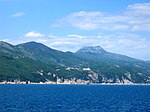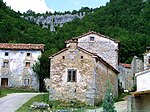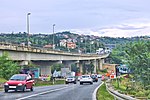Ćićarija
Dinaric AlpsKarst plateaus of SloveniaLandforms of Istria CountyPlateaus of CroatiaPlateaus of Inner Carniola
Ćićarija (Slovene: Čičarija; Italian: Cicceria, Monti della Vena; Istro Romanian: Ciceria; German: Tschitschen Boden) is a mountainous plateau in the northern and northeastern part of the Istria peninsula, 45 kilometers (28 mi) long and 10–15 kilometers (6.2–9.3 mi) wide. It mostly lies in Croatia, while its northern part lies in southwestern Slovenia (the traditional region of Inner Carniola). The highest peak is Veliki Planik at 1,272 meters (4,173 ft). At 7 inhabitants per square kilometer (18/sq mi) (2001), Ćićarija is sparsely populated, due to its karst landscape, poor economic development and rough climate.
Excerpt from the Wikipedia article Ćićarija (License: CC BY-SA 3.0, Authors).Ćićarija
R.P.O., Općina Lupoglav
Geographical coordinates (GPS) Address Nearby Places Show on map
Geographical coordinates (GPS)
| Latitude | Longitude |
|---|---|
| N 45.360555555556 ° | E 14.191944444444 ° |
Address
R.P.O.
R.P.O.
Općina Lupoglav
Croatia
Open on Google Maps









